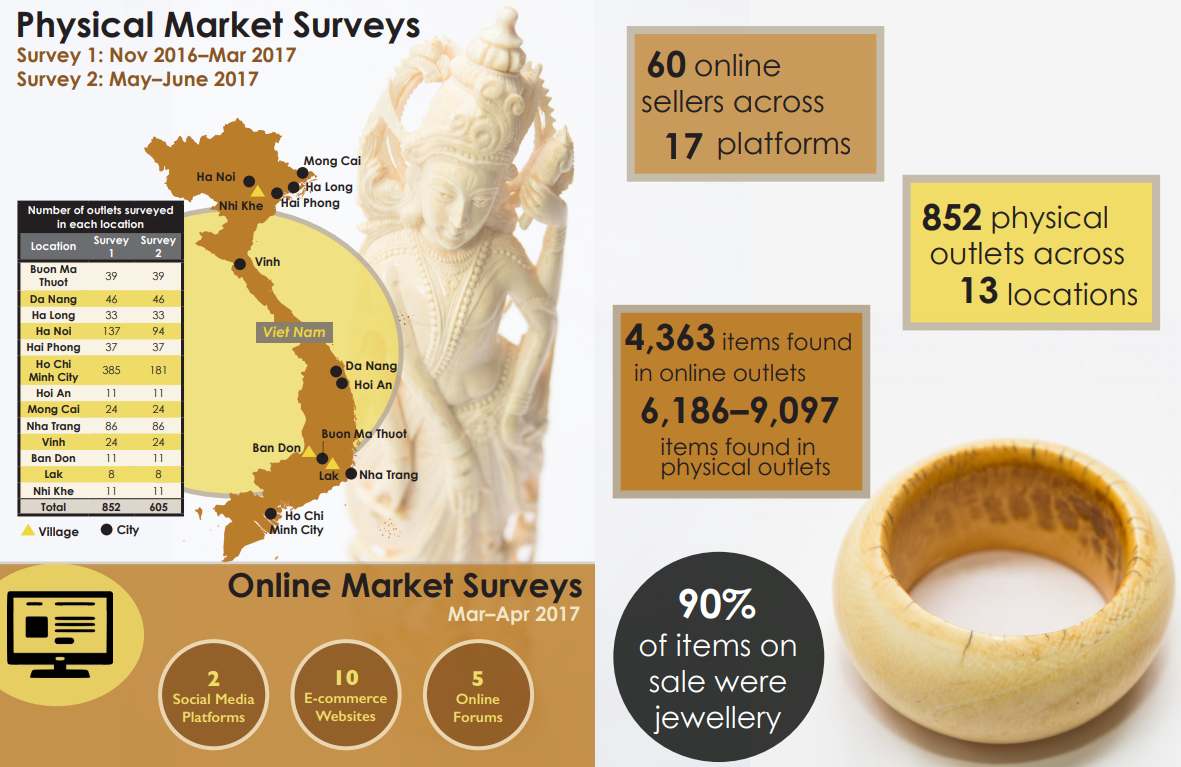
Tech & Sci
13:24, 17-Dec-2018
From retail to online stores, illegal ivory markets are thriving in Vietnam
Updated
12:43, 20-Dec-2018
Alok Gupta

Illegal ivory markets are thriving in Vietnam's tourist spots, online stores, and e-commerce sites, a survey revealed.
Around 10,549 ivory pieces were on sale at 852 physical outlets and 17 online platforms in 2018. The cost of these pieces ranged from seven to 2,500 U.S. dollars, around 154 items were priced over 200 U.S. dollars.
The report titled, From Tusk to Trinket: Persistent illegal ivory markets in Vietnam, also found a clear link between physical stores and online trade of ivory. The surveyors found that retail outlets are expanding their networks to sell ivory items online, the report said.
In eight instances, online sellers were either linked to physical stores or physical stores were also selling their items online through social media, e-commerce websites, or online forums.
“Although retailers know that selling ivory is illegal, it does not deter them from offering it openly for sale in Vietnam,” said Sarah Ferguson, Director of TRAFFIC in Vietnam.
“Regulatory and enforcement efforts must catch up to the markets, or the Vietnamese illegal ivory market will remain one of the largest in the world.”
Traders claimed ivory trinkets on sale had been procured from wild elephants in Vietnam. However, TRAFFIC and USAID officials who carried out the survey from November 2016 to June 2017, estimate that a fewer than 100 tuskers exist in the country's forest, meaning that procuring such a large number of trinkets from local elephant population appears impossible.
“It is highly likely the ivory originates from elsewhere, most of the ivory seized in Vietnam in the last few years has arrived from range countries of the African elephants,” TRAFFIC maintained.

Government's failure to implement an action plan has led to a thriving illegal ivory market in Vietnam. /TRAFFIC Graphics
Government's failure to implement an action plan has led to a thriving illegal ivory market in Vietnam. /TRAFFIC Graphics
An estimate suggests around 20,000 African elephants are killed every year for ivory, a majority of which is smuggled into Asian countries. International tourists, particularly from China were cited as significant buyers of ivory pieces. “Prices were sometimes quoted in currencies such as Chinese yuan and U.S. dollars,” the report said.
The survey captures the sale and purchasing trends of 2016-2017 that might have witnessed a considerable change as China banned ivory trade early this year. It also launched massive awareness drives at country's exit points such as airports announcing the move.
Moreover, a survey conducted in China by TRAFFIC in 2017 showed a large number of Chinese nationals are no longer interested in buying ivory products.
Researchers suggest plugging legislative loopholes, boosting enforcement capacity and increasing deterrents against criminal activity, restricting the market availability of ivory, and reducing consumer demand for ivory is required to put a leash on the illegal trade.
Concerned over the massive illegal ivory market, the Convention on International Trade in Endangered Species (CITES) instructed Vietnam to prepare a National Ivory Action Plan to curb illegal ivory trade. In October, CITES officials maintained that the country has still not “substantially achieved” implementation of its plan.
“Until Vietnam takes decisive action against its persistent illegal ivory markets in line with its commitments under CITES, it will continue to undermine the international response to the elephant poaching crisis,” said Minh Nguyen, a research official with TRAFFIC.
(Top Photo: Trinkets and figurines carved out of ivory pieces on sale at a shop in Vietnam. /TRAFFIC Photo)

SITEMAP
Copyright © 2018 CGTN. Beijing ICP prepared NO.16065310-3
Copyright © 2018 CGTN. Beijing ICP prepared NO.16065310-3